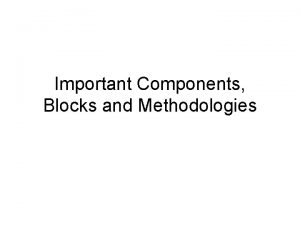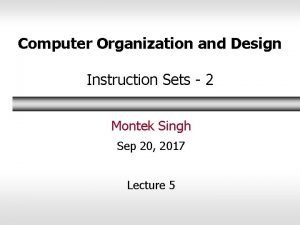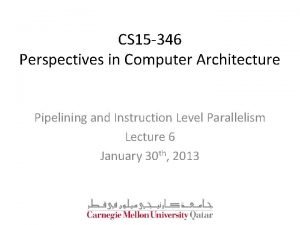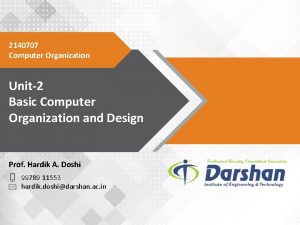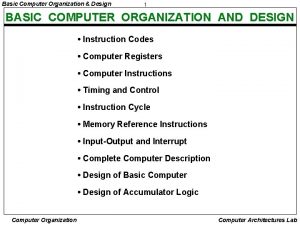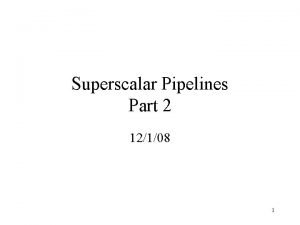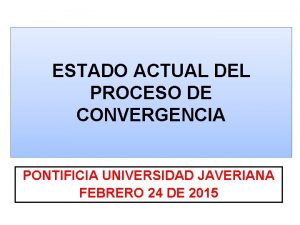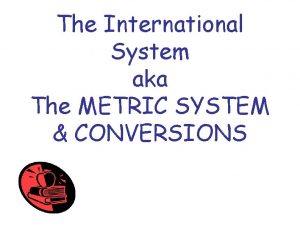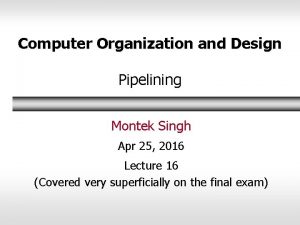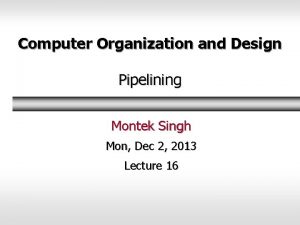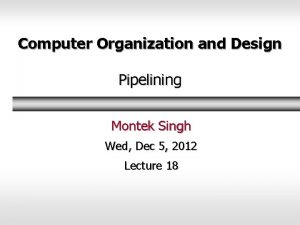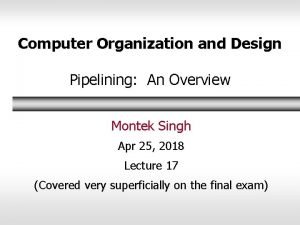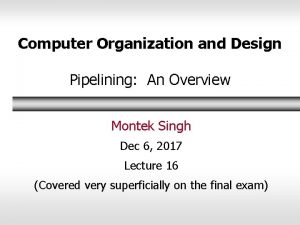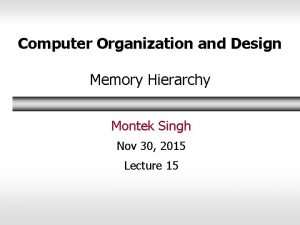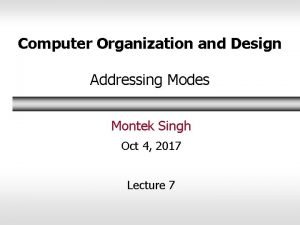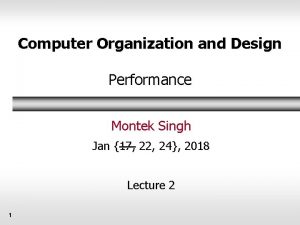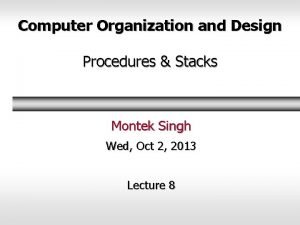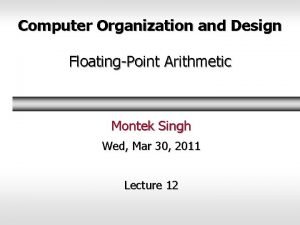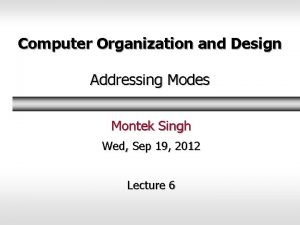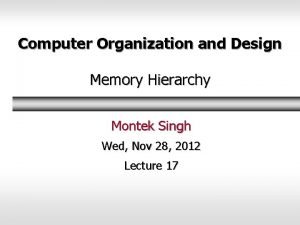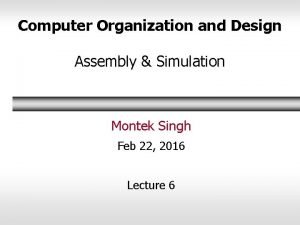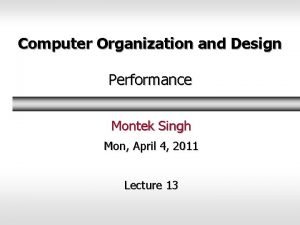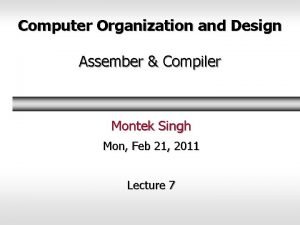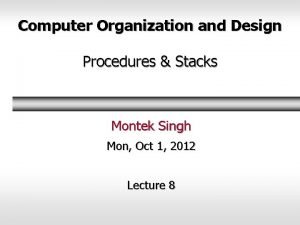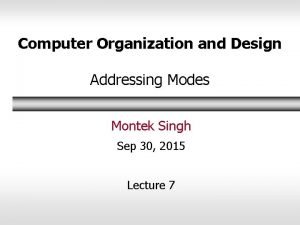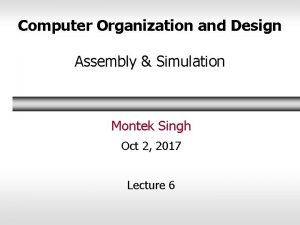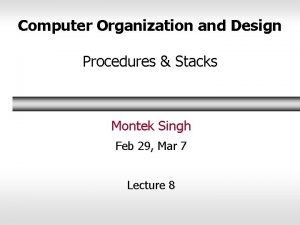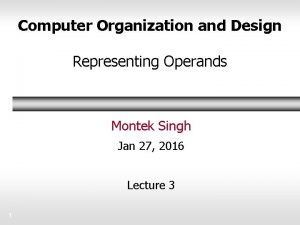Computer Organization and Design Pipelining Montek Singh Dec





















- Slides: 21

Computer Organization and Design Pipelining Montek Singh Dec 2, 2015 Lecture 16 (SELF STUDY – not covered on the final exam)

Pipelining Between 411 problems sets, I haven’t had a minute to do laundry Now that’s what I call dirty laundry

Laundry Example INPUT: dirty laundry Device: Washer Function: Fill, Agitate, Spin Washer. PD = 30 mins OUTPUT: 4 more weeks Device: Dryer Function: Heat, Spin Dryer. PD = 60 mins

Laundry: One Load at a Time ã Everyone knows that the real reason one puts off doing laundry so long is not because we procrastinate, are lazy, or even have better things to do. l The fact is, doing laundry one load at a time is not smart. Step 1: Step 2: Total = Washer. PD + Dryer. PD 90 = _____ mins

Laundry: Doing N Loads! ã Here’s how one would do laundry the “unpipelined” way. Step 1: Step 2: Step 3: Step 4: … Total = N*(Washer. PD + Dryer. PD) N*90 = ______ mins

Laundry: Doing N Loads! ã Here’s how to “pipeline” the laundry process. l Much more efficient! Step 1: Step 2: Step 3: Actually, it’s more like N*60 + 30 if we account for the startup time (i. e. , filling up the pipeline) correctly. When doing pipeline analysis, we’re mostly interested in the “steady state” where we assume we have an infinite supply of inputs. … Total = N * Max(Washer. PD, Dryer. PD) N*60 = ______ mins

Recall Our Performance Measures ã Latency: l Delay from input to corresponding output 90 Ø Unpipelined Laundry = _____ mins 120 Ø Pipelined Laundry = _____ mins ã Throughput: Assuming that the wash is started as soon as possible and waits (wet) in the washer until dryer is available. l Rate at which inputs or outputs are processed 1/90 Ø Unpipelined Laundry = _____ outputs/min 1/60 Ø Pipelined Laundry = _____ outputs/min Even though we increase latency, it takes less time per load

Pipelining Summary ã Advantages: l Higher throughput than combinational system l Different parts of the logic work on different parts of the problem… ã Disadvantages: l Generally, increases latency l Only as good as the *weakest* link (often called the pipeline’s BOTTLENECK)

Review of CPU Performance MIPS = Freq CPI MIPS = Millions of Instructions/Secon Freq = Clock Frequency, MHz CPI = Clocks per Instruction To Increase MIPS: 1. DECREASE CPI. - RISC simplicity reduces CPI to 1. 0. - CPI below 1. 0? State-of-the-art multiple instruction issue 2. INCREASE Freq. - Freq limited by delay alongest combinational path; hence - PIPELINING is the key to improving performance.

Where Are the Bottlenecks? 0 x 80000000 0 x 80000040 0 x 80000080 PCSEL Pipelining goal: Break LONG combinational paths memories, ALU in separate stages PC<31: 29>: J<25: 0>: 00 JT 6 5 4 3 BT 2 PC 1 0 00 A Instruction Memory D +4 J: <25: 0> Rs: <25: 21> WASEL Rd: <15: 11> Rt: <20: 16> 31 27 0 1 2 3 Rt: <20: 16> Register File RA 1 WA WA RD 1 RA 2 WD RD 2 WERF WE Imm: <15: 0> RESET IRQ Z N V C x 4 Control Logic PCSEL WASEL SEXT BSEL WDSEL ALUFN Wr WERF ASEL SEXT JT shamt: <10: 6> “ 16” + ASEL 0 1 2 1 0 BSEL BT A ALUFN B WD R/W Data Memory NV C Z Adr PC+4 0 1 2 WDSEL RD Wr

Goal: 5 -Stage Pipeline GOAL: Maintain (nearly) 1. 0 CPI, but increase clock speed to barely include slowest components (mems, regfile, ALU) APPROACH: structure processor as 5 -stage pipeline: IF Instruction Fetch stage: Maintains PC, fetches one instruction per cycle and passes it to ID/RF Instruction Decode/Register File stage: Decode control lines and select source operands ALU MEM WB ALU stage: Performs specified operation, passes result to … Memory stage: If it’s a lw, use ALU result as an address, pass mem data (or ALU result if not lw) to … Write-Back stage: writes result back into register file.

0 x 80000000 0 x 80000040 0 x 80000080 PCSEL 5 -Stage mini. MIPS PC<31: 29>: J<25: 0>: 00 JT 6 5 4 3 BT 2 1 PC 0 00 A Instruction Fetch D +4 PCREG • Omits some details Instruction Memory IRREG 00 Rs: <25: 21> J: <25: 0> Register File RA 1 WA RD 1 JT Imm: <15: 0> Register File shamt: <10: 6> “ 16” 1 0 BSEL BT PCALU 00 IRALU B A ALUFN Memory ASEL 0 1 2 A ALU RD 2 BZ x 4 + RA 2 = SEXT Rt: <20: 16> WDALU Address is available right after instruction enters Memory stage B NV C Z PCMEM 00 YMEM IRMEM WDMEM Adr PC+4 PCWB 00 R/W Wr Data Memory YWB IRWB WD RD Rt: <20: 16> Rd: <15: 11> WASEL Write Back “ 31” “ 27” 0 1 WA WERF WA WE 2 3 Register File 0 1 WD 2 WDSEL Data is needed just before rising clock edge at end of Write Back stage

Pipelining ã Improve performance by increasing instruction throughput Ideal speedup is number of stages in the pipeline. Do we achieve this?

Pipelining ã What makes it easy l all instructions are the same length l just a few instruction formats l memory operands appear only in loads and stores ã What makes it hard? l structural hazards: suppose we had only one memory l control hazards: need to worry about branch instructions l data hazards: an instruction depends on a previous instruction ã Net effect: l Individual instructions still take the same number of cycles l But improved throughput by increasing the number of simultaneously executing instructions

Data Hazards ã Problem with starting next instruction before first is finished l dependencies that “go backward in time” are data hazards

Software Solution ã Have compiler guarantee no hazards l Where do we insert the “nops” ? Ø Between “producing” and “consuming” instructions! sub and or add sw $2, $1, $3 $12, $5 $13, $6, $2 $14, $2 $15, 100($2) ã Problem: this really slows us down!

Forwarding ã Bypass/forward results as soon as they are produced/needed. Don’t wait for them to be written back into registers!

Can't always forward ã Load word can still cause a hazard: l an instruction tries to read a register following a load instruction that writes to the same register. STALL!

Stalling ã When needed, stall the pipeline by keeping an instruction in the same stage fpr an extra clock cycle.

Branch Hazards ã When branching, other instructions are in the pipeline! l need to add hardware for flushing instructions if we are wrong

Pipeline Summary ã A very common technique to improve throughput of any circuit l used in all modern processors! ã Fallacies: l “Pipelining is easy. ” No, smart people get it wrong all of the time! l “Pipelining is independent of ISA. ” No, many ISA decisions impact how easy/costly it is to implement pipelining (i. e. branch semantics, addressing modes). l “Increasing pipeline stages improves performance. ” No, returns diminish because of increasing complexity.
 Sarwan singh kundan singh
Sarwan singh kundan singh Arti montek
Arti montek 9 bit
9 bit Montek x 1000
Montek x 1000 Which pipeline is linear
Which pipeline is linear Scalar pipeline in computer architecture
Scalar pipeline in computer architecture Process organization in computer organization
Process organization in computer organization Diff between computer architecture and organization
Diff between computer architecture and organization Flowchart for memory reference instructions
Flowchart for memory reference instructions 2140707
2140707 Design of basic computer with flowchart
Design of basic computer with flowchart Basic computer organization and design
Basic computer organization and design Basic structure of computer in computer organization
Basic structure of computer in computer organization Pipelining and superscalar techniques
Pipelining and superscalar techniques Scalar pipeline
Scalar pipeline Bi tri quad pent hex hept oct
Bi tri quad pent hex hept oct Jauge outil fraisage
Jauge outil fraisage Dec. 3022/13
Dec. 3022/13 Km hec dec m dm cm mm
Km hec dec m dm cm mm Nys dec decals
Nys dec decals 8th dec 2014
8th dec 2014 Ra dec
Ra dec


